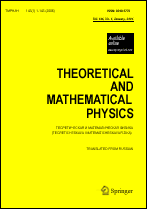|
Quasiharmonic longitudinal wave propagating in a Mindlin–Herrmann rod in a nonlinearly elastic environment
V. I. Erofeev, A. V. Leontieva
Institute for Problems of Mechanical Engineering,
Russian Academy of Sciences — a branch of the Federal State Budget
Scientific Institution "Federal Research Center of the Institute
for Applied Physics, RAS," Nizhnii Novgorod, Russia
Abstract:
We consider the modulation instability of quasiharmonic longitudinal waves propagating in a homogeneous rod immersed in a nonlinearly elastic medium. The dynamic behavior of the rod is determined by the Mindlin–Herrmann theory, which refines the technical theory of rods. The accuracy of the model is ensured by describing the motion of the rod particles in the transverse direction and rejecting the hypothesis that the transverse strains due to the axial extension or contraction are proportional to the longitudinal strain. The system of equations describing the longitudinal vibrations of the rod reduces to a single nonlinear fourth-order equation for the longitudinal displacement of the rod particles. The multiscale method is used to derive the nonlinear Schrödinger equation, which is one of the basic equations of nonlinear wave dynamics. The Lighthill criterion is used to determine the domains of modulation instability. It is shown how the boundaries of these domains move as the parameters characterizing the elastic properties of the rod material and the medium nonlinearity change. The influence of the parameters of the system on the wave packets and the main parameters of envelope solitons (amplitude, speed, width) is analyzed.
Keywords:
modulation instability, longitudinal wave, Mindlin–Herrmann model, nonlinearly elastic medium, envelope soliton.
Received: 20.01.2022
Revised: 09.02.2022
Citation:
V. I. Erofeev, A. V. Leontieva, “Quasiharmonic longitudinal wave propagating in a Mindlin–Herrmann rod in a nonlinearly elastic environment”, TMF, 211:2 (2022), 216–235; Theoret. and Math. Phys., 211:2 (2022), 625–641
Linking options:
https://www.mathnet.ru/eng/tmf10253https://doi.org/10.4213/tmf10253 https://www.mathnet.ru/eng/tmf/v211/i2/p216
|


|




 Contact us:
Contact us: Terms of Use
Terms of Use
 Registration to the website
Registration to the website Logotypes
Logotypes








 Citation in format
Citation in format 